Increasing Exploitation Durability of Two-Layer Cast Mill Rolls and Assessment of the Applicability of the XGBoost Machine Learning Method to Manage Their Quality
Abstract
1. Introduction
2. Materials and Methods
3. Results and Discussion
3.1. The Evaluation of the Capability of the XGBoost Method to Predict the Exploitation Durability of Two-Layer Cast Mill Rolls
3.2. The Analysis of the Structure and Phase Composition of HCCI Depending on Chromium Content
3.3. Cyclic Heat Treatment of HCCIs
4. Conclusions
Author Contributions
Funding
Institutional Review Board Statement
Informed Consent Statement
Data Availability Statement
Acknowledgments
Conflicts of Interest
References
- Zhao, J.; Li, J.; Qie, H.; Shao, J.; Wang, X.; Yang, Q. Online Prediction of Deformation Resistance for Strip Tandem Cold Rolling Based on Data-Driven. Metals 2023, 13, 737. [Google Scholar] [CrossRef]
- Paar, A.; Aigner, M.; Reiter, M.; Fischbacher, M.; Laubbichler, I. Influence of Carbide Types and Amounts on the Wear of Graphite-Containing Alloys for Work Rolls. Steel Res. Int. 2023, 94, 2200485. [Google Scholar] [CrossRef]
- Chabak, Y.; Efremenko, V.; Zurnadzhy, V.; Puchý, V.; Petryshynets, I.; Efremenko, B.; Fedun, V.; Shimizu, K.; Bogomol, I.; Kulyk, V.; et al. Structural and Tribological Studies of “(TiC+WC)/Hardened Steel” PMMC Coating Deposited by Air Pulsed Plasma. Metals 2022, 12, 218. [Google Scholar] [CrossRef]
- Aigner, M.; Beentjes, D.; Bolt, H.; Elizondo, L.; Paar, A. On the Performance and Surface Quality of Graphitic HSS Roll Grades at Tata Steel’s Direct Sheet Plant. In Proceedings of the AISTech 2023 Proceedings, Detroit, MI, USA, 8–11 May 2023; pp. 1818–1827. [Google Scholar]
- Efremenko, B.V.; Shimizu, K.; Espallargas, N.; Efremenko, V.G.; Kusumoto, K.; Chabak, Y.G.; Belik, A.G.; Chigarev, V.V.; Zurnadzhy, V.I. High-temperature Solid Particle Erosion of Cr-Ni-Fe-C Arc Cladded Coatings. Wear 2020, 460–461, 203439. [Google Scholar] [CrossRef]
- Meng, L.; Ding, J.; Dong, Z.; Sun, J.; Zhang, D.; Gou, J. Prediction of Roll Wear and Thermal Expansion Based on Informer Network in Hot Rolling Process and Application in the Control of Crown and Thickness. J. Manuf. Process. 2023, 103, 248–260. [Google Scholar] [CrossRef]
- Lu, K.; Pan, X.; Mi, C.; Wang, W.; Zhang, J.; Chen, P.; Wang, B. RDDPA: Real-Time Defect Detection via Pruning Algorithm on Steel Surface. ISIJ Int. 2024, 64, 1019–1028. [Google Scholar] [CrossRef]
- Lu, K.; Wang, W.; Feng, X.; Zhou, Y.; Chen, Z.; Zhao, Y.; Wang, B. FCCNet: Surface Defects Identification of Hot Rolled Strip Based on Lightweight Convolutional Neural Network. ISIJ Int. 2023, 63, 2010–2016. [Google Scholar] [CrossRef]
- Gdoutos, E.; Konsta-Gdoutos, M. Nondestructive Testing (NDT). In Mechanical Testing of Materials; Solid Mechanics and Its Applications; Springer Nature Switzerland: Cham, Switzerland, 2024; Volume 275, pp. 201–225. ISBN 978-3-031-45989-4. [Google Scholar]
- García-Martín, J.; Gómez-Gil, J.; Vázquez-Sánchez, E. Non-Destructive Techniques Based on Eddy Current Testing. Sensors 2011, 11, 2525–2565. [Google Scholar] [CrossRef]
- Li, Z.; Meng, Z. A Review of the Radio Frequency Non-Destructive Testing for Carbon-Fibre Composites. Meas. Sci. Rev. 2016, 16, 68–76. [Google Scholar] [CrossRef]
- Aderhold, J.; Meinlschmidt, P.; Schlüter, F. Heat Flow Thermography for Non-Destructive Testing of Composites and Natural Materials—An Application-Oriented Overview. tm-Tech. Mess. 2020, 87, 414–427. [Google Scholar] [CrossRef]
- Haghshenas, A.; Khonsari, M.M. Non-Destructive Testing and Fatigue Life Prediction at Different Environmental Temperatures. Infrared Phys. Technol. 2019, 96, 291–297. [Google Scholar] [CrossRef]
- Zhu, Y.-K.; Tian, G.-Y.; Lu, R.-S.; Zhang, H. A Review of Optical NDT Technologies. Sensors 2011, 11, 7773–7798. [Google Scholar] [CrossRef] [PubMed]
- Lopez, A.; Bacelar, R.; Pires, I.; Santos, T.G.; Sousa, J.P.; Quintino, L. Non-Destructive Testing Application of Radiography and Ultrasound for Wire and Arc Additive Manufacturing. Addit. Manuf. 2018, 21, 298–306. [Google Scholar] [CrossRef]
- Su, Y.; Dong, L.; Pei, Z. Non-Destructive Testing for Cavity Damages in Automated Machines Based on Acoustic Emission Tomography. Sensors 2022, 22, 2201. [Google Scholar] [CrossRef] [PubMed]
- Mustafa, S.; Peer, A.; Concli, F. Non-Destructive Crack Detection Methodologies in Green Compacts: An Overview. In Flexible Automation and Intelligent Manufacturing: Establishing Bridges for More Sustainable Manufacturing Systems; Silva, F.J.G., Pereira, A.B., Campilho, R.D.S.G., Eds.; Lecture Notes in Mechanical Engineering; Springer Nature Switzerland: Cham, Switzerland, 2024; pp. 836–847. ISBN 978-3-031-38240-6. [Google Scholar]
- Blitz, J. Electrical and Magnetic Methods of Non-Destructive Testing; Non-Destructive Evaluation Series; Springer: Dordrecht, The Netherlands, 1997; Volume 3, ISBN 978-94-010-6457-6. [Google Scholar]
- Juraszek, J. Residual Magnetic Field Non-Destructive Testing of Gantry Cranes. Materials 2019, 12, 564. [Google Scholar] [CrossRef] [PubMed]
- Li, K.; Liu, Y.; Lu, Z.; Wang, P.; Zhang, Z.; Zeng, J. A Nondestructive Testing Method of Incremental Permeability Based on Permanent Magnet Movement Magnetization. Russ. J. Nondestruct. Test. 2022, 58, 320–332. [Google Scholar] [CrossRef]
- Huijuan, Y.; Enjing, Z.; Hongmei, L.; Jian, F.; Ying, Y.Y.; Ying, Z.; Dandan, H. Application Status of the Barkhausen Effect in Nondestructive Testing. TELKOMNIKA 2014, 12, 523. [Google Scholar] [CrossRef][Green Version]
- Tsybriy, I.K.; Koval, N.S.; Topolskaya, I.A. Coercimeter for Non-Destructive Control of Solid Alloys. J. Phys. Conf. Ser. 2021, 2131, 052042. [Google Scholar] [CrossRef]
- Cofiño-Villar, A.; Alvarez-Antolin, F.; Alvarez-Perez, C.H. Improvement in the Resistance to Wear of Work-Rolls Used in Finishing Stands of the Hot Strip Mills. Metals 2021, 11, 1873. [Google Scholar] [CrossRef]
- Jain, A.-S.; Chang, H.; Tang, X.; Hinckley, B.; Zhang, M.-X. Refinement of Primary Carbides in Hypereutectic High-Chromium Cast Irons: A Review. J. Mater. Sci. 2021, 56, 999–1038. [Google Scholar] [CrossRef]
- Efremenko, V.G.; Chabak, Y.G.; Shimizu, K.; Golinskyi, M.A.; Lekatou, A.G.; Petryshynets, I.; Efremenko, B.V.; Halfa, H.; Kusumoto, K.; Zurnadzhy, V.I. The Novel Hybrid Concept on Designing Advanced Multi-Component Cast Irons: Effect of Boron and Titanium (Thermodynamic modelling, microstructure and mechanical property evaluation). Mater. Charact. 2023, 197, 112691. [Google Scholar] [CrossRef]
- Gimaletdinov, R.H.; Gulakov, A.A.; Tukhvatulin, I.H.; Petrov, A.V.; Filippov, V.S. Development of Sheet Rolling Roll Production from Advanced Materials in the Kushva Rolling Roll Plant. Metallurgist 2021, 65, 160–168. [Google Scholar] [CrossRef]
- Vlasovets, V.; Vlasenko, T.; Kovalyshyn, S.; Shchur, T.; Bilovod, O.; Shulga, L.; Łapka, M.; Koszel, M.; Parafiniuk, S.; Rydzak, L. Improving the Performance Properties of Eutectoid Steel Products by a Complex Effect. Materials 2022, 15, 8552. [Google Scholar] [CrossRef] [PubMed]
- Brykov, M.N.; Petryshynets, I.; Džupon, M.; Kalinin, Y.A.; Efremenko, V.G.; Makarenko, N.A.; Pimenov, D.Y.; Kováč, F. Microstructure and Properties of Heat Affected Zone in High-Carbon Steel after Welding with Fast Cooling in Water. Materials 2020, 13, 5059. [Google Scholar] [CrossRef] [PubMed]
- Niekurzak, M.; Kubińska-Jabcoń, E. Assessment of the Impact of Wear of the Working Surface of Rolls on the Reduction of Energy and Environmental Demand for the Production of Flat Products: Methodological Approach. Materials 2022, 15, 2334. [Google Scholar] [CrossRef]
- Cofiño-Villar, A.; Alvarez-Antolin, F.; Asensio-Lozano, J.; Garcia-Garcia, M. Control over the Percentage, Shape and Size of the Graphite Particles in Martensitic White Castings Alloyed with Cr, Nb and Mg. Materials 2019, 12, 185. [Google Scholar] [CrossRef] [PubMed]
- Efremenko, B.V.; Chabak, Y.G.; Efremenko, V.G.; Vlasovets, V.M. Kinetics of Structure Transformation in Pulsed Plasma High-Cr Coatings under Post-Heat Treatment. Funct. Mater. 2020, 27, 117–124. [Google Scholar] [CrossRef]
- Vlasovets, V.; Kovalyshyn, S.; Kurpaska, S.; Vlasenko, T.; Kovalyshyn, O.; Shchur, T.; Bilovod, O.; Shulga, L. Improving the Operational Properties of Centrifugal Cast Rolls with a Working Layer of Chromium Cast Iron with Microstructure Assessment by Computer Vision. In Proceedings of the International Scientific Conference “BALTTRIB 2022”, Vytautas Magnus University, Agriculture Academy, Akademija, Lithuania, 21 December 2023; pp. 86–95. [Google Scholar]
- Vlasovets, V. Effect of Various Factors on the Measurement Error of Structural Components of Machine Parts Materials Microhardness Using Computer Vision Methods. Electrotech. Rev. 2023, 1, 325–331. [Google Scholar] [CrossRef]
- Ermushin, D.Y.; Bolobanova, N.L. Investigation of Surface Strain Hardening of the Barrel of Back-up Rolls in the Finishing Group of a Broadband Hot Rolling Mill. Chernye Met. 2023, 27–32. [Google Scholar] [CrossRef]
- Skoblo, T.S.; Vlasovets, V.M. Specific Features of the Formation of Structures in 60Kh2N4GMF Precipitation-Hardening Steel. Mater. Sci. 2012, 47, 644–650. [Google Scholar] [CrossRef]
- Li, X.; Luan, F.; Wu, Y. A Comparative Assessment of Six Machine Learning Models for Prediction of Bending Force in Hot Strip Rolling Process. Metals 2020, 10, 685. [Google Scholar] [CrossRef]
- Wang, Z.; Huang, Y.; Liu, Y.; Wang, T. Prediction Model of Strip Crown in Hot Rolling Process Based on Machine Learning and Industrial Data. Metals 2023, 13, 900. [Google Scholar] [CrossRef]
- Tryhuba, I.; Tryhuba, A.; Hutsol, T.; Cieszewska, A.; Andrushkiv, O.; Glowacki, S.; Bryś, A.; Slobodian, S.; Tulej, W.; Sojak, M. Prediction of Biogas Production Volumes from Household Organic Waste Based on Machine Learning. Energies 2024, 17, 1786. [Google Scholar] [CrossRef]
- Mosayebi, M.; Zarrinkolah, F.; Farmanesh, K. Calculation of Stiffness Parameters and Vibration Analysis of a Cold Rolling Mill Stand. Int. J. Adv. Manuf. Technol. 2017, 91, 4359–4369. [Google Scholar] [CrossRef]
- Cofiño-Villar, A.; Alvarez-Antolin, F.; Asensio-Lozano, J. Enhancement of the Quality of the Shell-Core Bond Interface in Duplex Work Rolls Manufactured by Centrifugal Casting Used in Hot Strip Mills. Materials 2019, 12, 1304. [Google Scholar] [CrossRef]
- Huang, S.; He, X.; Zhang, X.; Li, W. Prediction of Mechanical Properties of Hot Rolled Strip Based on DBN and Composite Expectile Regression. Funct. Mater. 2022, 29, 279. [Google Scholar] [CrossRef]
- Li, W.; Xie, L.; Zhao, Y.; Li, Z.; Wang, W. Prediction Model for Mechanical Properties of Hot-Rolled Strips by Deep Learning. J. Iron Steel Res. Int. 2020, 27, 1045–1053. [Google Scholar] [CrossRef]
- Li, F.; He, A.; Song, Y.; Wang, Z.; Xu, X.; Zhang, S.; Qiang, Y.; Liu, C. Deep Learning for Predictive Mechanical Properties of Hot-Rolled Strip in Complex Manufacturing Systems. Int. J. Min. Met. Mater. 2023, 30, 1093–1103. [Google Scholar] [CrossRef]
- Sitek, W.; Trzaska, J. Practical Aspects of the Design and Use of the Artificial Neural Networks in Materials Engineering. Metals 2021, 11, 1832. [Google Scholar] [CrossRef]
- Li, G.; Gong, D.; Lu, X.; Zhang, D. Ensemble Learning Based Methods for Crown Prediction of Hot-Rolled Strip. ISIJ Int. 2021, 61, 1603–1613. [Google Scholar] [CrossRef]
- Myśliwiec, P.; Kubit, A.; Szawara, P. Optimization of 2024-T3 Aluminum Alloy Friction Stir Welding Using Random Forest, XGBoost, and MLP Machine Learning Techniques. Materials 2024, 17, 1452. [Google Scholar] [CrossRef] [PubMed]
- Mahmoodkhani, Y.; Wells, M.A.; Song, G. Prediction of Roll Force in Skin Pass Rolling Using Numerical and Artificial Neural Network Methods. Ironmak. Steelmak. 2017, 44, 281–286. [Google Scholar] [CrossRef]
- Laha, D.; Ren, Y.; Suganthan, P.N. Modeling of Steelmaking Process with Effective Machine Learning Techniques. Expert Syst. Appl. 2015, 42, 4687–4696. [Google Scholar] [CrossRef]
- Hu, Z.; Wei, Z.; Sun, H.; Yang, J.; Wei, L. Optimization of Metal Rolling Control Using Soft Computing Approaches: A Review. Arch. Comput. Methods Eng. 2021, 28, 405–421. [Google Scholar] [CrossRef]
- Ding, C.; Sun, J.; Li, X.; Peng, W.; Zhang, D. Intelligent Diagnosis for Hot-Rolled Strip Crown with Unbalanced Data Using a Hybrid Multi-Stage Ensemble Model. J. Cent. South Univ. 2024, 31, 762–782. [Google Scholar] [CrossRef]
- Dong, Z.; Li, X.; Zhang, D. Rolling Force Prediction of Hot-Rolled Transverse Thickness-Varying Plates Based on Stochastic Configuration Network. In Proceedings of the 2023 5th International Conference on Industrial Artificial Intelligence (IAI), Shenyang, China, 21 August 2023; pp. 1–6. [Google Scholar]
- Cao, L.; Li, X.; Li, X.; Dong, Z.; Zhang, D. Variable Speed Rolling Force Prediction with Theoretical and Data-Driven Models. Int. J. Mech. Sci. 2024, 264, 108833. [Google Scholar] [CrossRef]
- Gaudez, S.; Macchi, J.; Geandier, G. Thermodynamic Approach to Describe the Martensite Phase Transformation Kinetics via the Stabilization of Austenite. Met. Mater. Trans. 2024, A55, 812–826. [Google Scholar] [CrossRef]
- Oanh, N.T.H.; Viet, N.H. Precipitation of M23C6 Secondary Carbide Particles in Fe-Cr-Mn-C Alloy during Heat Treatment Process. Metals 2020, 10, 157. [Google Scholar] [CrossRef]
- Porter, D.A.; Easterling, K.E.; Sherif, M.Y. Phase Transformations in Metals and Alloys, 3rd ed.; CRC Press: Boca Raton, FL, USA, 2009; ISBN 978-1-4200-6210-6. [Google Scholar]
- Chabak, Y.; Efremenko, V.; Džupon, M.; Shimizu, K.; Fedun, V.; Wu, K.; Efremenko, B.; Petryshynets, I.; Pastukhova, T. Evaluation of the Microstructure, Tribological Characteristics, and Crack Behavior of a Chromium Carbide Coating Fabricated on Gray Cast Iron by Pulsed-Plasma Deposition. Materials 2021, 14, 3400. [Google Scholar] [CrossRef]
- Cheng, X.; Zhang, D.; Wu, X.; Xu, G.; Fu, H. Effect of Quenching Temperature on Microstructure and Properties of Low Silicon Hypereutectic High Chromium Cast Iron. Metall. Res. Technol. 2023, 120, 102. [Google Scholar] [CrossRef]
- Nayak, U.P.; Mücklich, F.; Guitar, M.A. Time-Dependant Microstructural Evolution and Tribological Behaviour of a 26 Wt% Cr White Cast Iron Subjected to a Destabilization Heat Treatment. Met. Mater. Int. 2023, 29, 934–947. [Google Scholar] [CrossRef]
- Singh, J.; Nath, S.K. Effects of Cyclic Heat Treatment on Microstructure and Mechanical Properties of 13%Cr-4%Ni Martensitic Stainless Steel. J. Mater. Eng. Perform. 2020, 29, 2478–2490. [Google Scholar] [CrossRef]
- Kang, N.; Lin, X.; Mansori, M.E.; Wang, Q.Z.; Lu, J.L.; Coddet, C.; Huang, W.D. On the Effect of the Thermal Cycle during the Directed Energy Deposition Application to the In-Situ Production of a Ti-Mo Alloy Functionally Graded Structure. Addit. Manuf. 2020, 31, 100911. [Google Scholar] [CrossRef]
- Zhong, F.; Wang, J.; Zhang, Q.; Huang, J.; Wang, W.; Xu, J.; Huang, K.; Qin, Y. Residual Stress Reductions of Carbide Cutting Tools through Applying Pulsed Magnetic Field and Coupled Electromagnetic Field—Mechanism Analysis and Comparison Study. Int. J. Adv. Manuf. Technol. 2022, 121, 4757–4775. [Google Scholar] [CrossRef]
- Liu, B.; Fu, P.; Gu, J.; He, P.; Fang, J.; Dong, L. Study on the influence of ultrasonic impact treatment (UIT) on stress evaluation of laser cladding coating by using metal magnetic memory technology. Eng. Fail. Anal. 2023, 143, 106936. [Google Scholar] [CrossRef]
- Sadeghi, B.; Cavaliere, P. Effect of Bimodal Grain Structure on the Microstructural and Mechanical Evolution of Al-Mg/CNTs Composite. Metals 2021, 11, 1524. [Google Scholar] [CrossRef]
- Jia, T.; Ni, R.; Wang, H.; Shen, J.; Wang, Z. Investigation on the Formation of Cr-Rich Precipitates at the Interphase Boundary in Type 430 Stainless Steel Based on Austenite–Ferrite Transformation Kinetics. Metals 2019, 9, 1045. [Google Scholar] [CrossRef]
- Voyiadjis, G.Z.; Yaghoobi, M. Size Effects in Plasticity: From Macro to Nano; Elsevier, Academic Press: London, UK; San Diego, CA, USA; Cambridge, MA, USA; Kidlington, Oxford, UK, 2019; ISBN 978-0-12-812236-5. [Google Scholar]
- Tandon, V.; Park, K.-S.; Khatirkar, R.; Gupta, A.; Choi, S.-H. Evolution of Microstructure and Crystallographic Texture in Deformed and Annealed BCC Metals and Alloys: A Review. Metals 2024, 14, 149. [Google Scholar] [CrossRef]



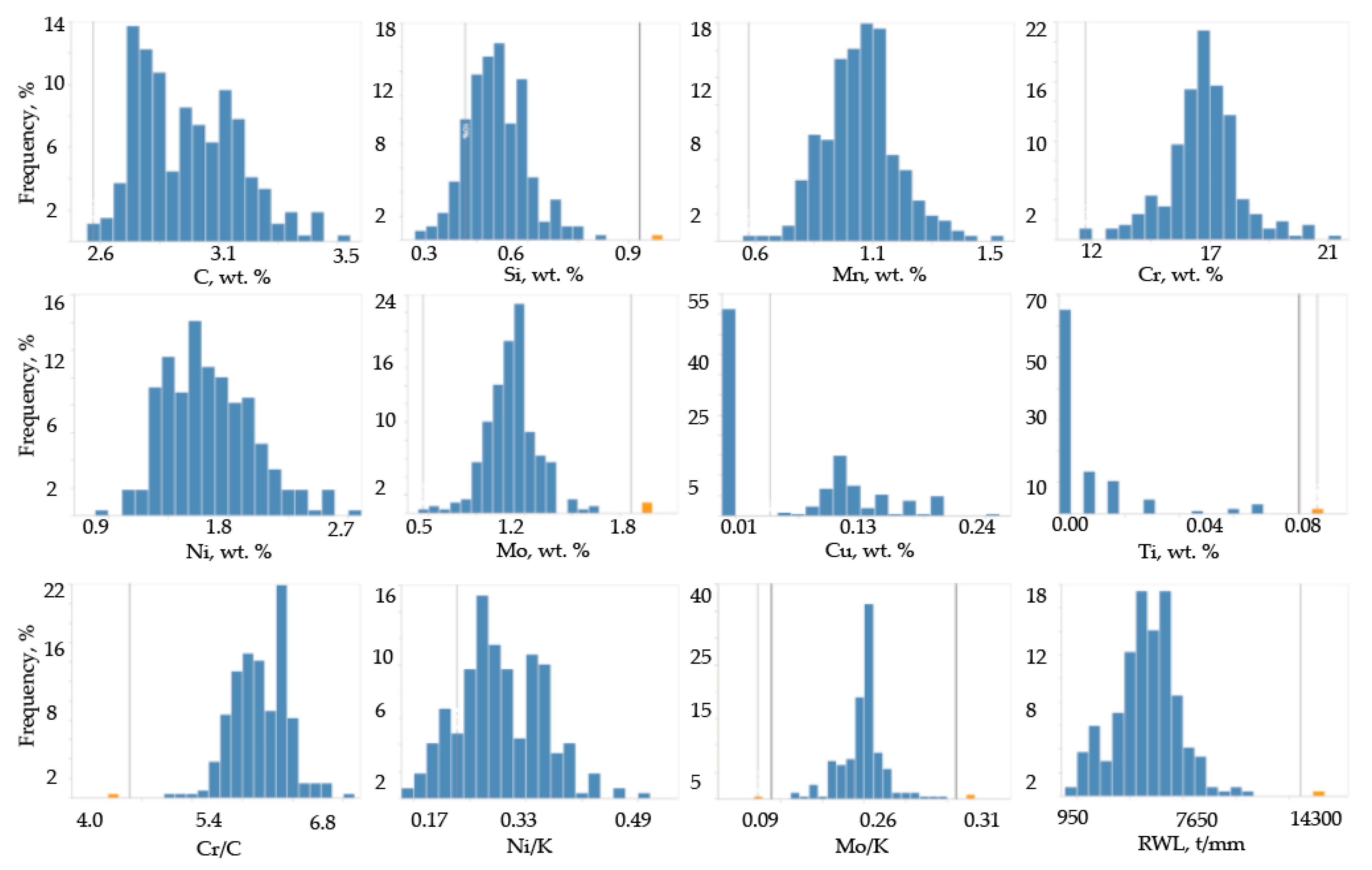


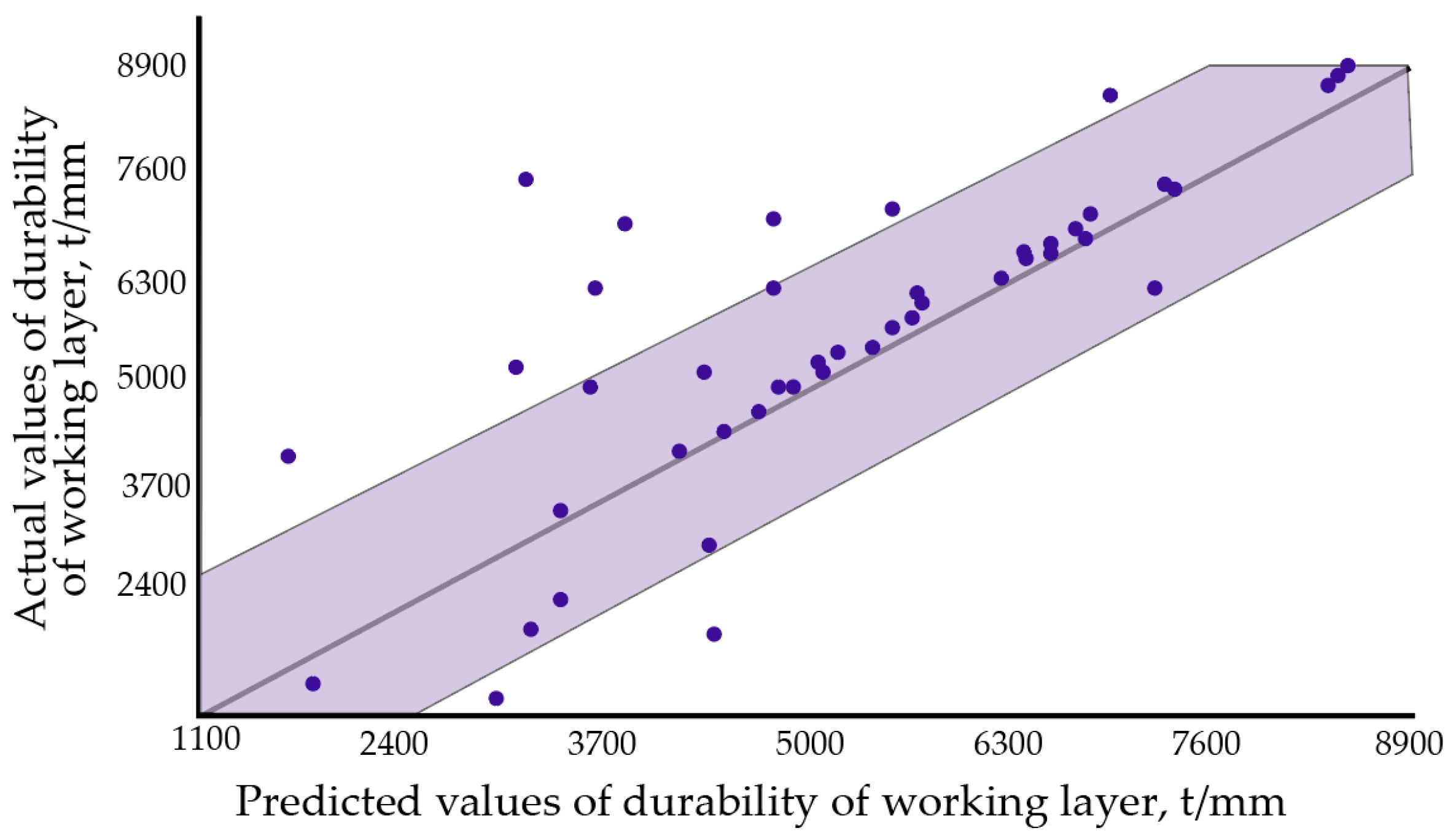
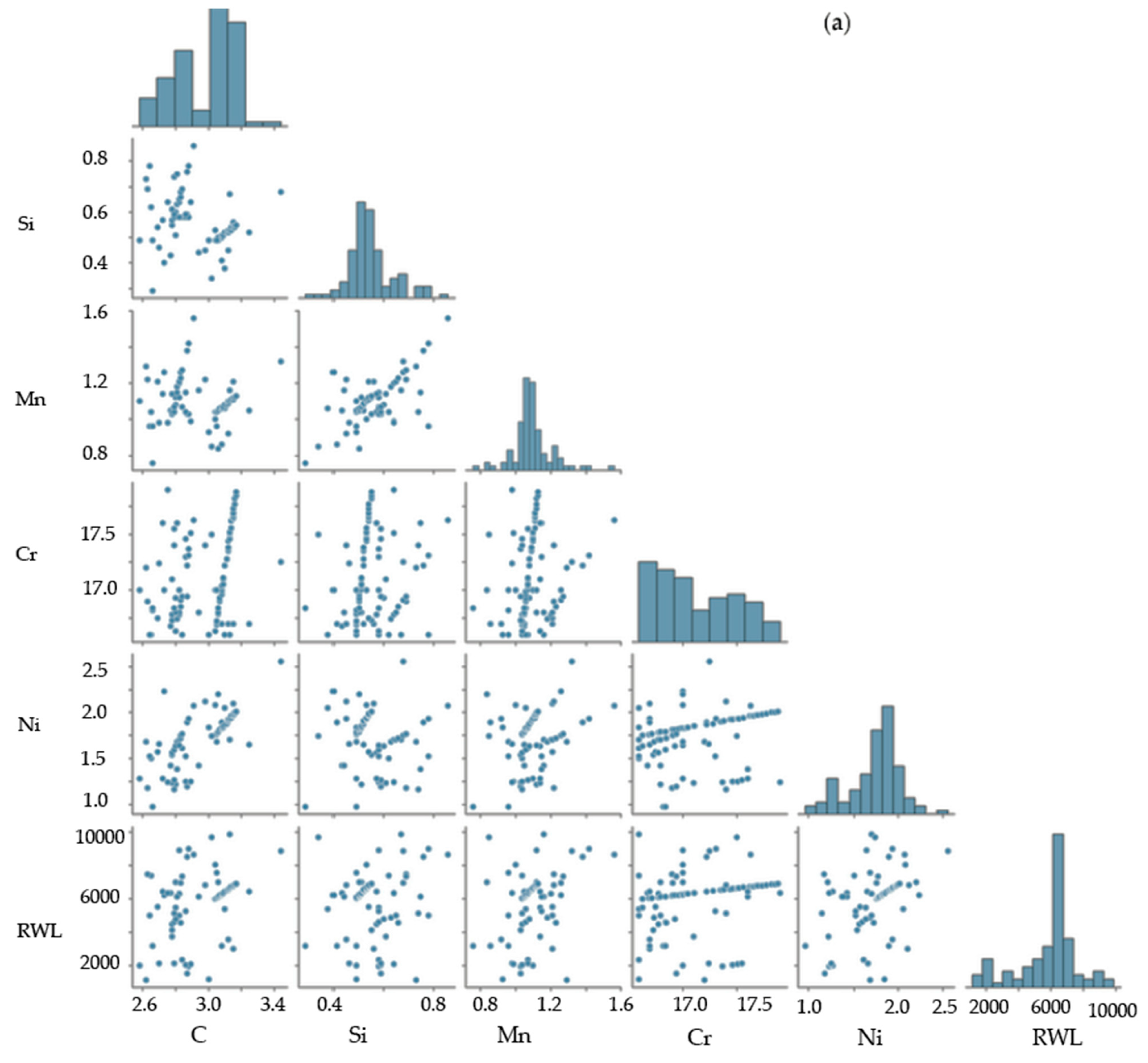
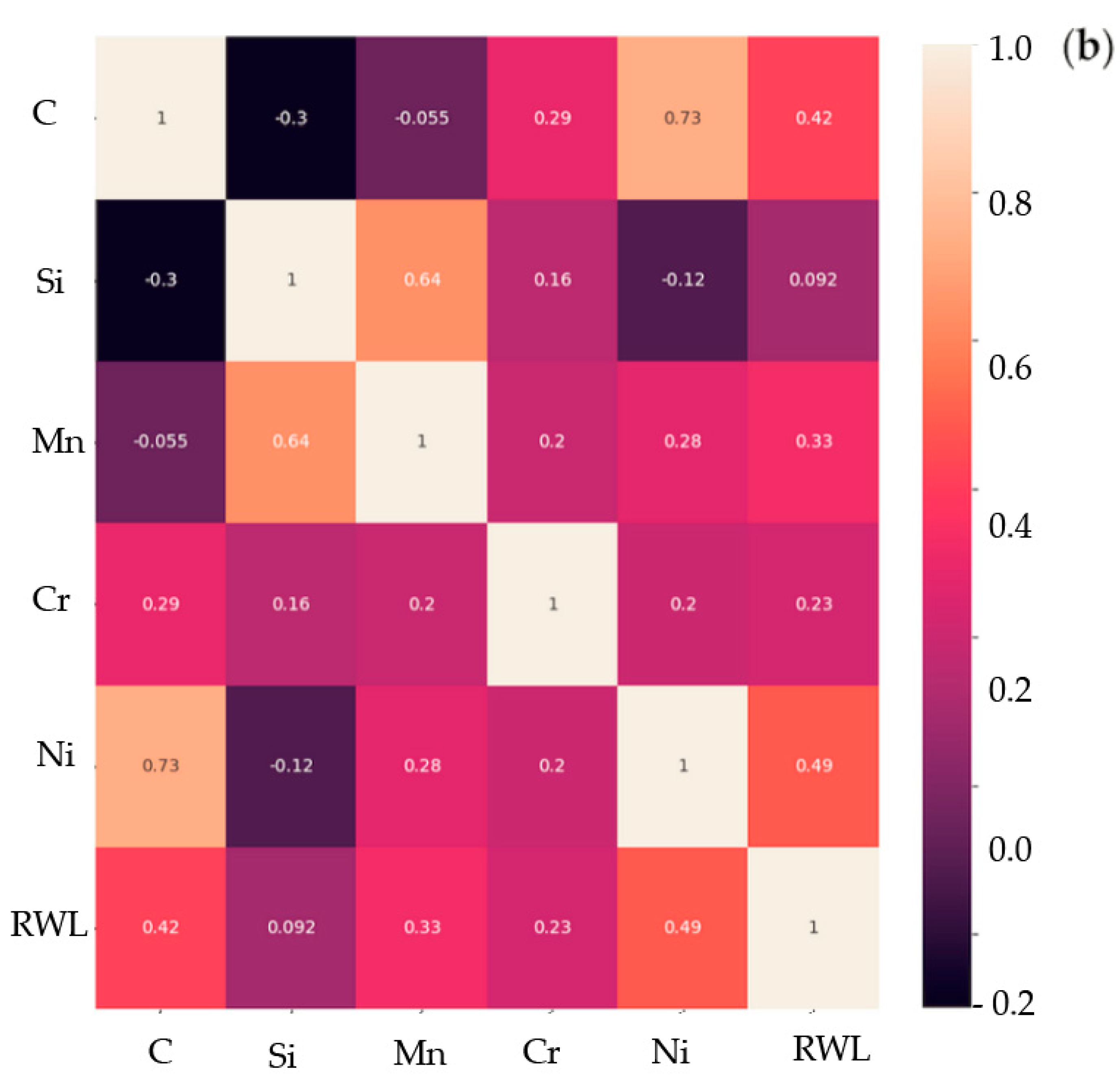
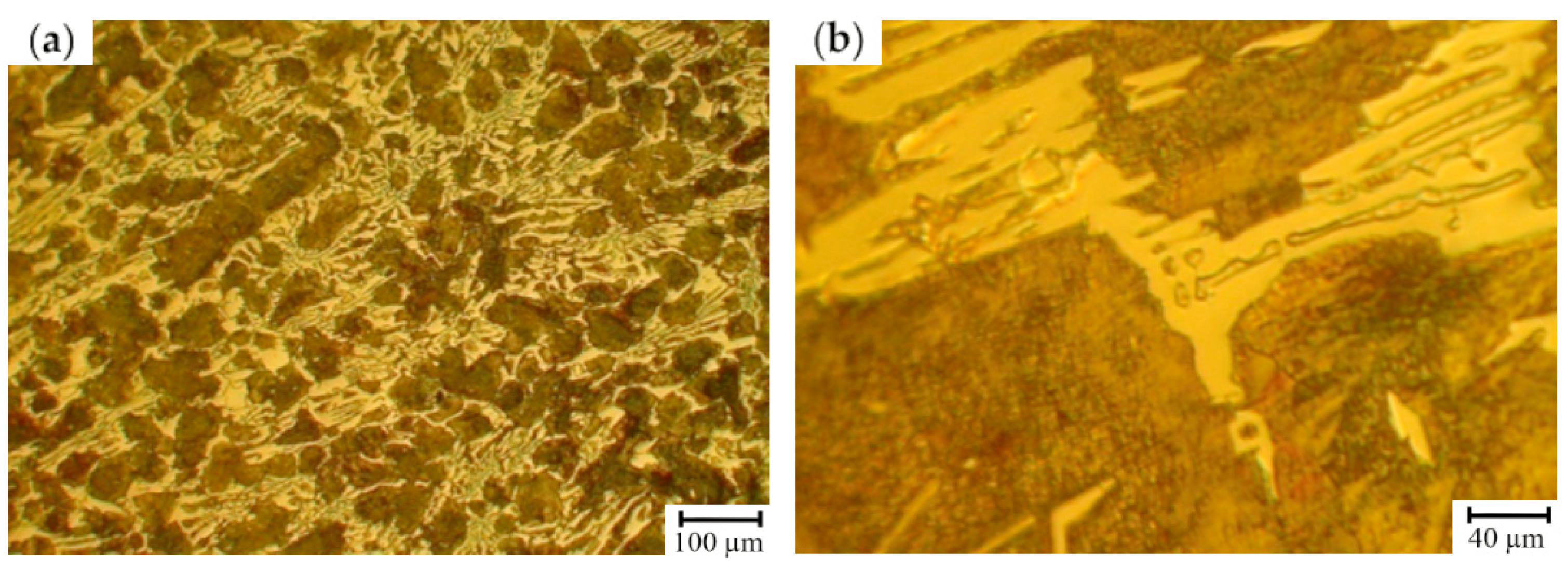
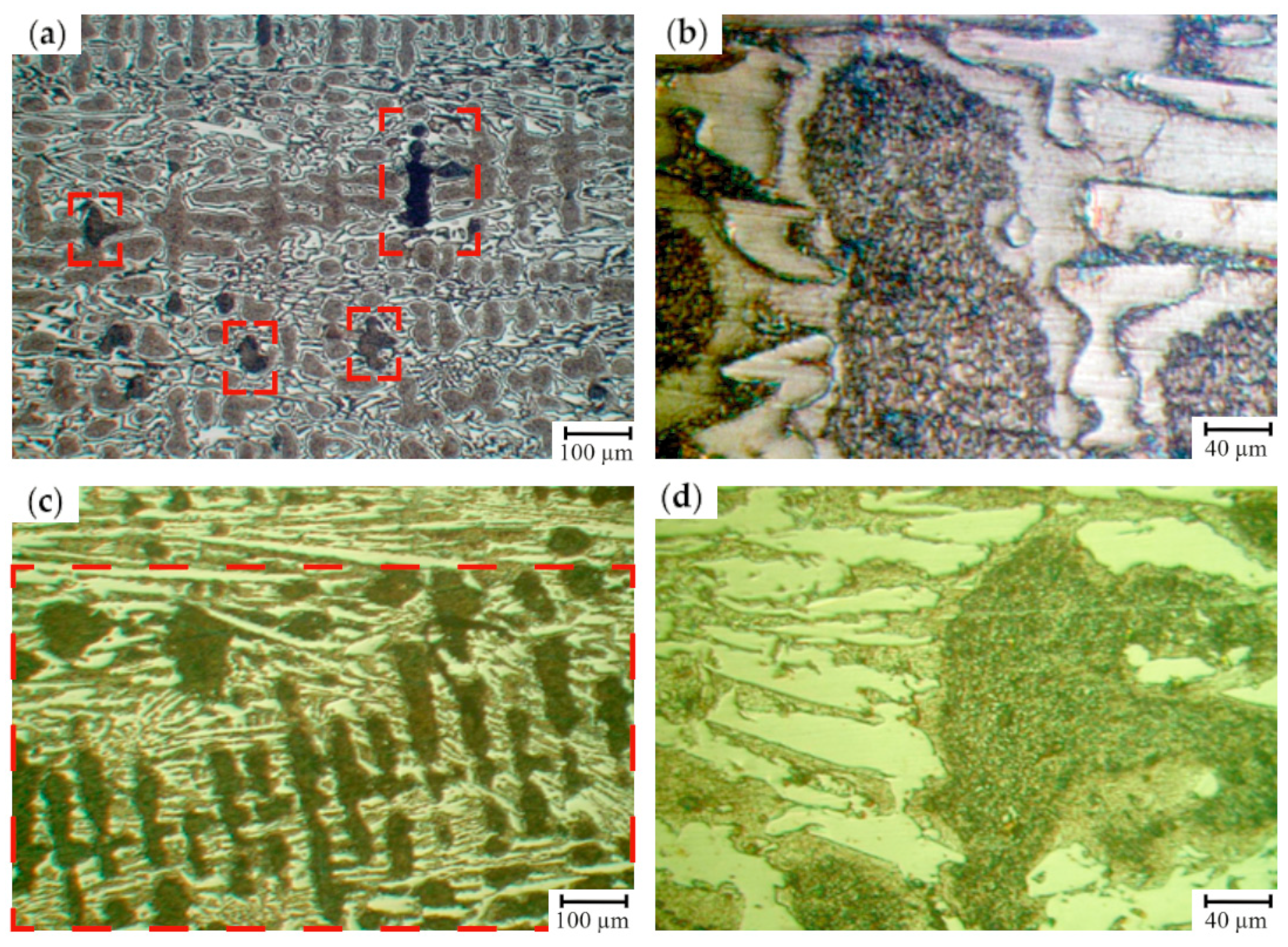


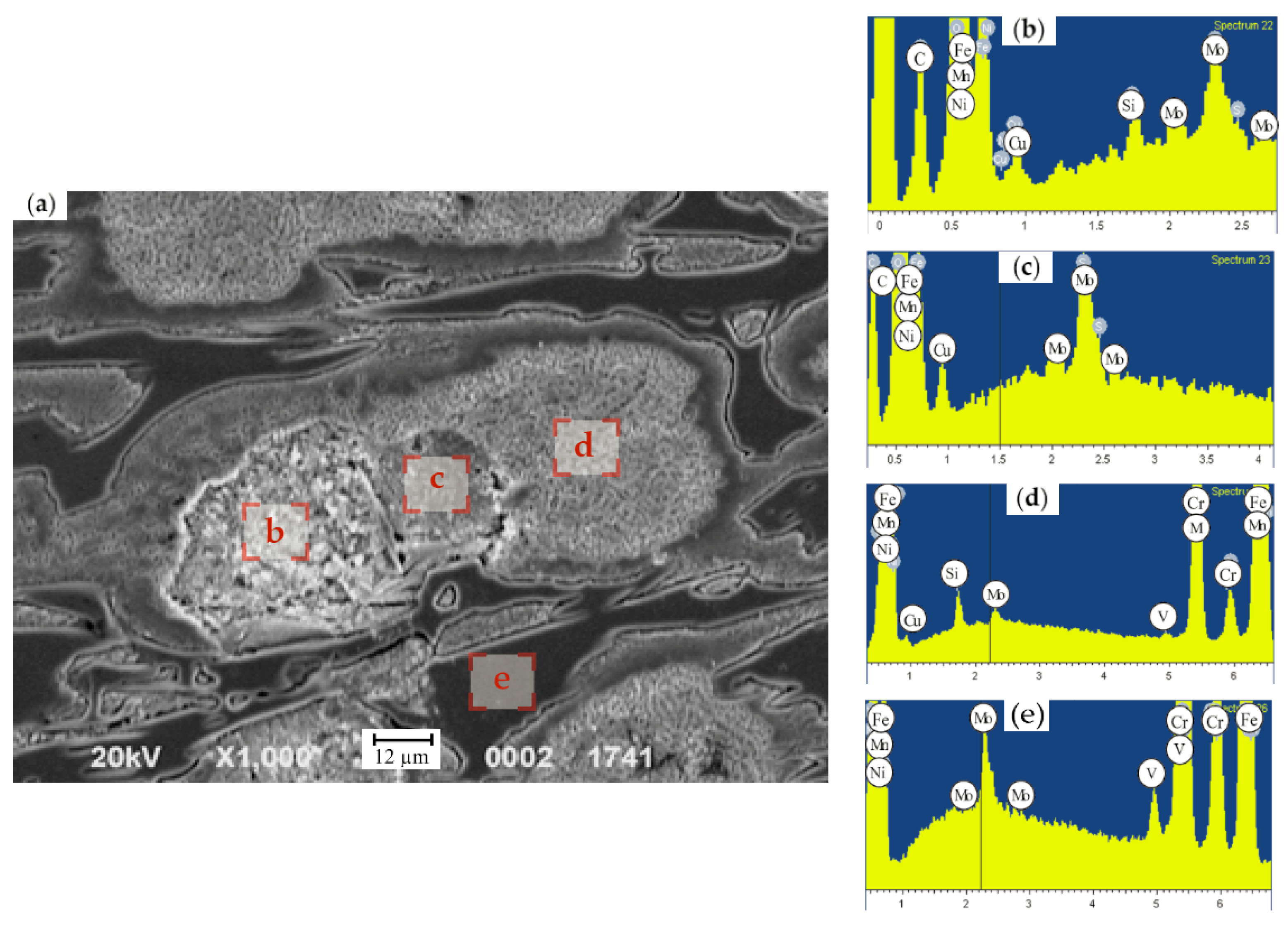
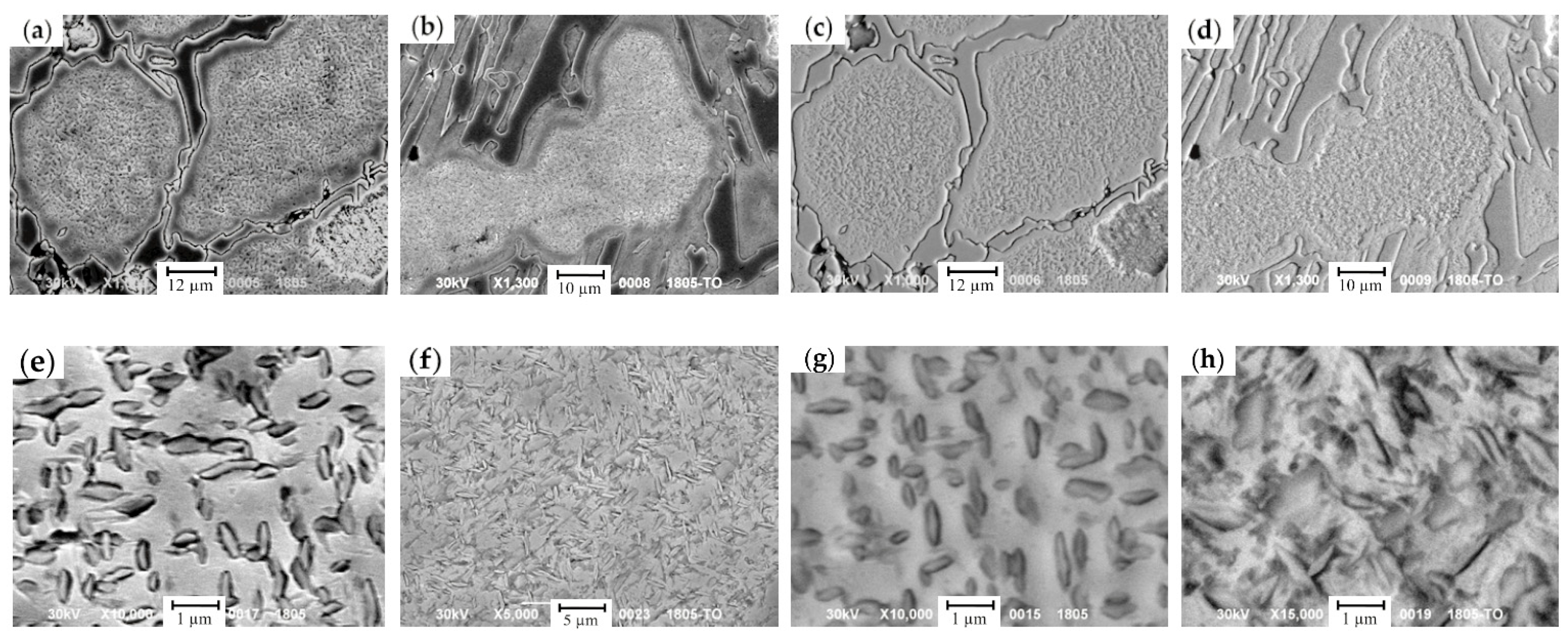
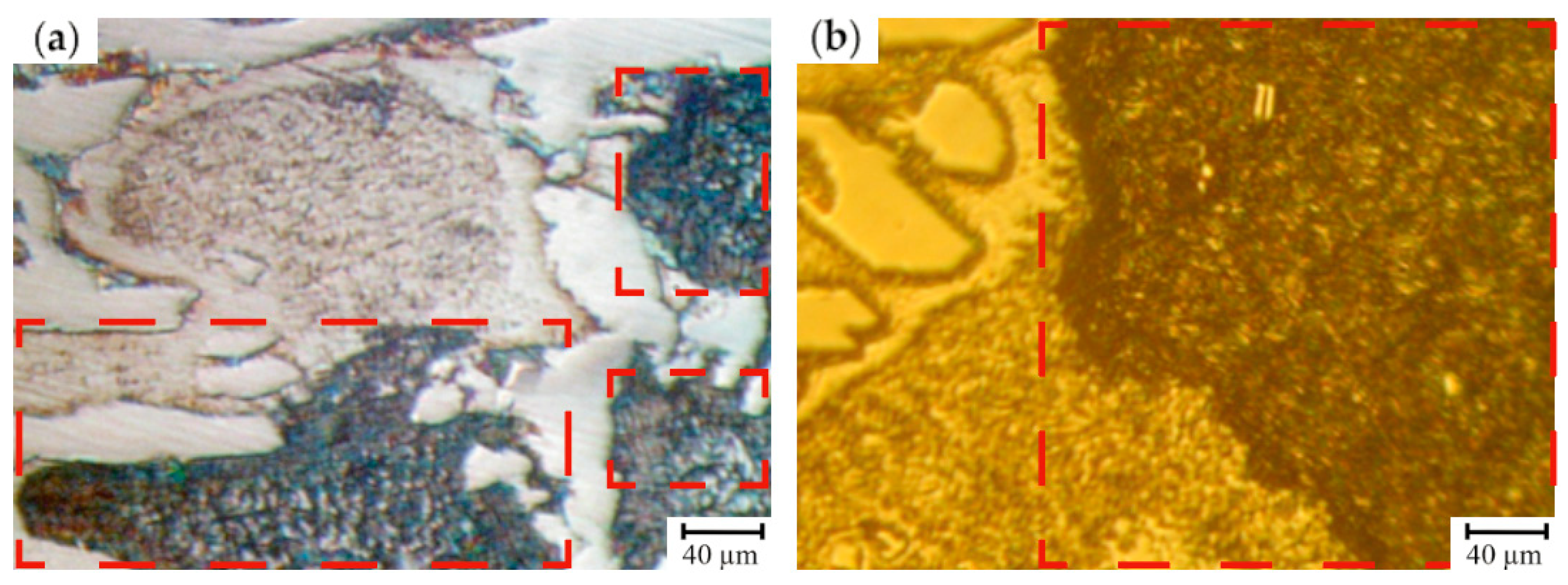
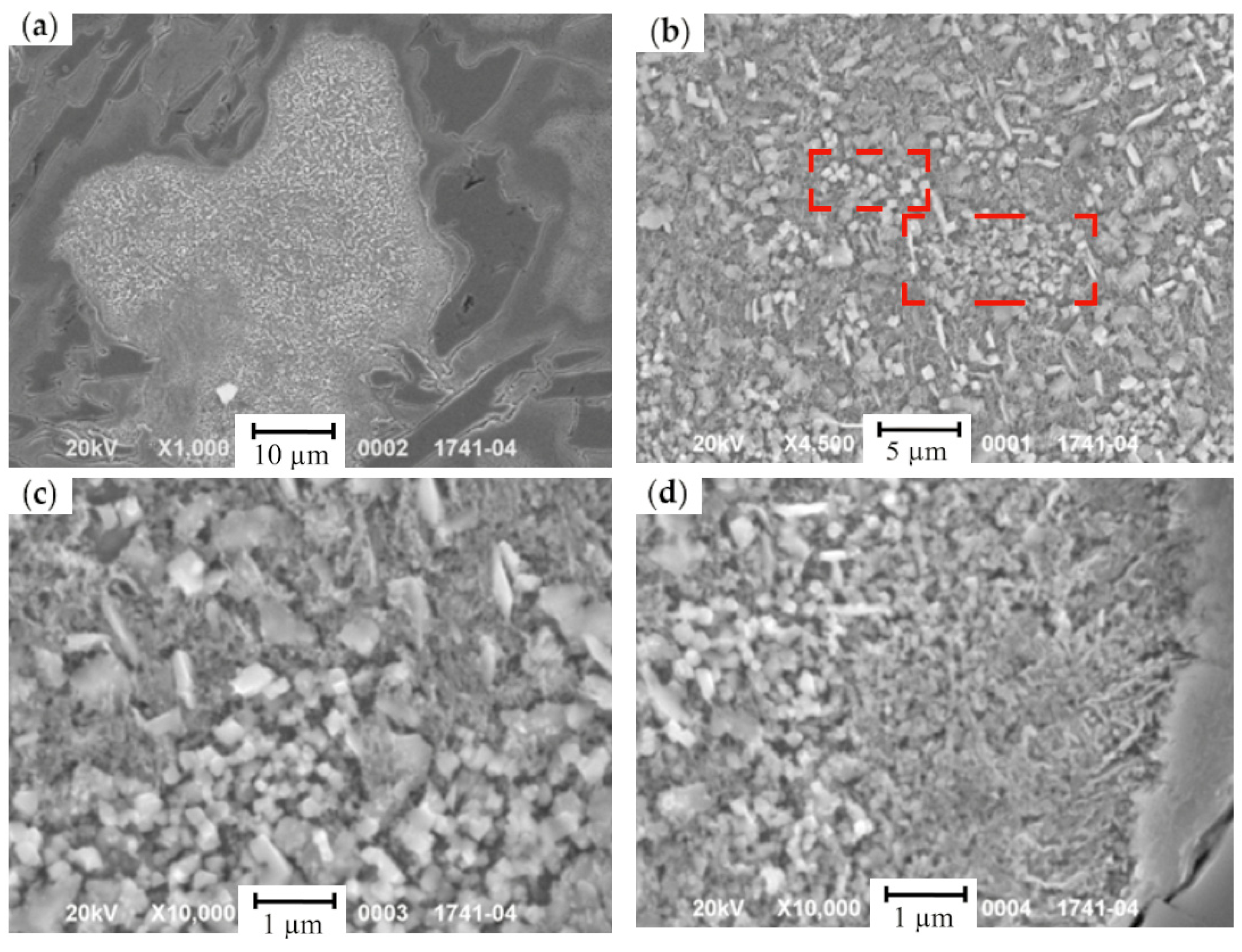

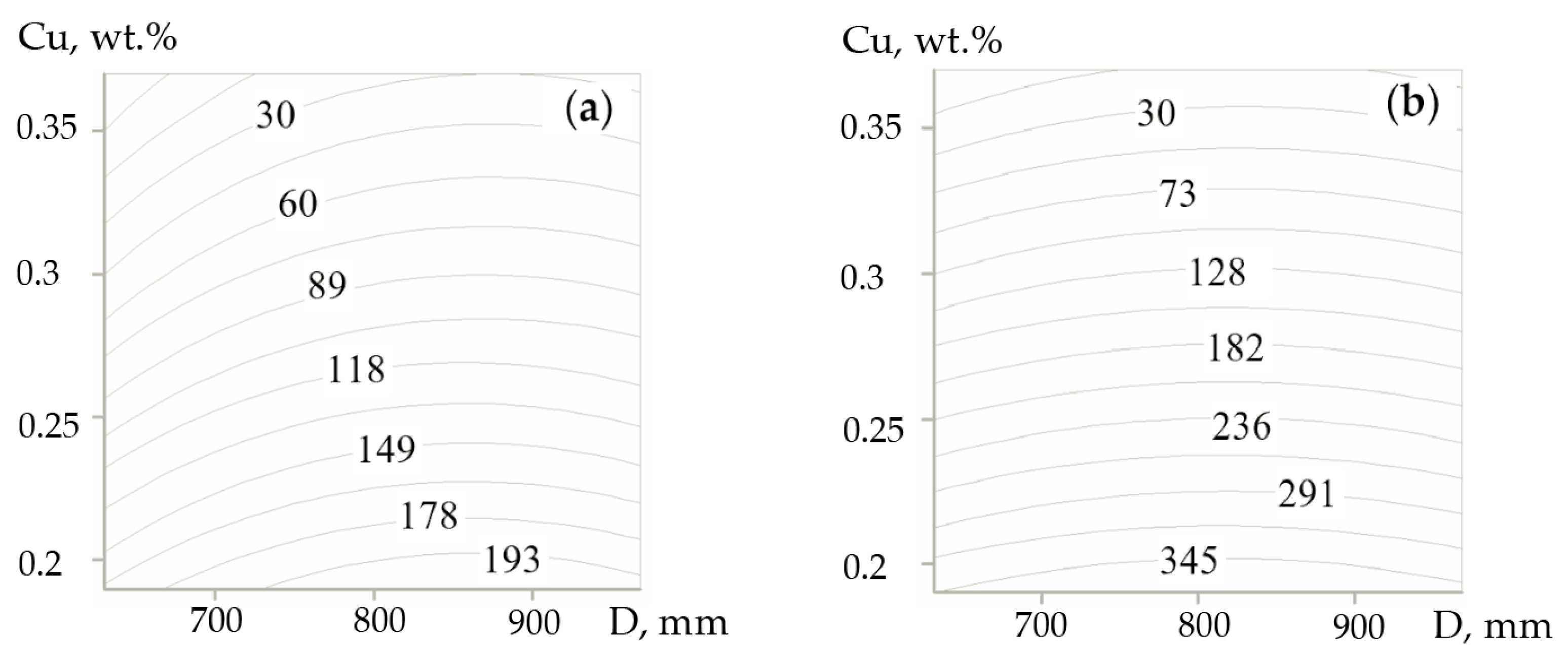

| Values | Features | Unit | Designations | Distribution Limits | Symbol |
|---|---|---|---|---|---|
| Manufacturing stage | C | wt.% | x1 | 2.56–3.56 | C |
| Si | wt.% | x2 | 0.24–0.98 | Si | |
| Mn | wt.% | x3 | 0.59–1.56 | Mn | |
| P | wt.% | x4 | 0.03–0.23 | P | |
| S | wt.% | x5 | 0.01–0.06 | S | |
| Cr | wt.% | x6 | 11.8–18.8 | Cr | |
| Ni | wt.% | x7 | 0.76–2.8 | Ni | |
| Mo | wt.% | x8 | 0.47–1.44 | Mo | |
| Mg | wt.% | x9 | 0.0–0.04 | Mg | |
| Cu | wt.% | x10 | 0.04–1.17 | Cu | |
| Ti | wt.% | x11 | 0.006–0.11 | Ti | |
| V | wt.% | x12 | 0.01–0.44 | V | |
| Cr/C | - | x13 | 3.83–6.93 | Cr_C | |
| Ni/(Cr/C) | - | x14 | 0.18–0.45 | Ni_K | |
| Mo/(Cr/C) | - | x15 | 0.1–0.33 | Mo_K | |
| Annealing temperature | °C | x16 | 450–500 | annealing | |
| The temperature of cyclic treatment | °C | x17 | 400–700 | double_annealing | |
| Exploitation | Barrel diameter (start) | mm | y1 | 664–915 | dstart |
| Barrel diameter (after exploitation) | mm | y2 | 663–909 | dfinish | |
| Number of roll changes | pcs | y3 | 1–207 | number_transhipm | |
| Rolled | ton | y4 | 2190–464,255 | rolled | |
| The thickness of removed layer per one roll change | mm | y5 | 0.18–3.60 | removal_transshipm | |
| Durability of working layer | ton/mm | y6 | 206–17,600 | RWL_tmm | |
| Durability of working layer | ton | y7 | 1260–3750 | RWL_tlayer | |
| The state of a barrel surface after the exploitation | See footnote 1 | y8–14 | Scrap—14.5% | Condition | |
| Club—12.7% | |||||
| Wear—10.9% | |||||
| Barrel—1.82% | |||||
| Breaking—1.82% | |||||
| Spalling-off—1.82% | |||||
| Neck—1.82% |
| Value | C | Si | Mn | Ni | Cr | Mo | Ti | V | Cu |
|---|---|---|---|---|---|---|---|---|---|
| The total scatter | 2.56–3.56 | 0.24–0.98 | 0.59–1.56 | 0.76–2.8 | 11.8–18.8 | 0.47–1.44 | 0.006–0.11 | 0.01–0.44 | 0.04–1.17 |
| Mean | 2.75 | 0.84 | 0.93 | 1.37 | 16.50 | 1.11 | 0.01 | 0.26 | 0.22 |
| Roll Designation | Size | Chips | Cracks | Breakdowns/ Detachments | Grid Cracks | Average Operating Time on the Roll | Total Rolls Analyzed |
|---|---|---|---|---|---|---|---|
| Centrifugal Cast | |||||||
| DLCrNiMo—73 1 | 820 × 2000 | 5 | 2 | –/8 | 2 | 153,800 | 37 |
| DLCr17NiMo—58 2 | 900 × 2000 | 1 | 1 | –/2 | 1 | 139,738 | 14 |
| DLCr17NiMo—63 2 | 900 × 2000 | 2 | 3 | 1/2 | 9 | 190,623 | 38 |
| DLCr17NiMo—63 2 | 820 × 2300 | – | 1 | –/– | 2 | 140,194 | 6 |
| Stationary Cast | |||||||
| DLCrNi—63 3 | 900 × 2000 | 7 | 2 | –/1 | 11 | 180,932 | 75 |
| DLCrNiMo—73 4 | 820 × 2000 | 8 | – | 2/32 | 9 | 140,980 | 110 |
| DLCrNiMo—73 4 | 820 × 2300 | 2 | – | 1/3 | 15 | 147,335 | 90 |
| Parameter | Value |
|---|---|
| n_estimators | 80 |
| max_depth | 50 |
| learning_rate | 0.1 |
| Parameter | Value |
|---|---|
| MSE (mean squared error) | 1,196,491 |
| RMSE (root mean squared error) | 1094 |
| R2 | 0.61 |
| MAE (mean absolute error) | 617 |
| Parameters | Sample Group | ||
|---|---|---|---|
| 12.0–14.0 wt.% Cr | 16.6–17.9 wt.% Cr | 15.9–16.4 wt.% Cr with Mo | |
| MSE | 1,828,335 | 690,033 | 1,579,079 |
| RMSE | 1352 | 830 | 1256 |
| R2 | 0.344 | 0.396 | 0.254 |
| MAE | 740 | 516 | 933 |
| Designation of Roll | The Volume Fraction of Structural Constituents, vol.% | |||
|---|---|---|---|---|
| Troostite | Ferrite–Carbide Mixture, Characterized by Weak Etching | Cementite | Austenite | |
| 1 | 33.0 | 35.0 | 18.0 | 14.0 |
| 2 | 49.0 | 3.5 | 22.5 | 28.5 |
| 3 | 52.4 | 7.0 | 18.0 | 22.6 |
| 4 | 71.2 | 5.5 | 12.0 | 11.3 |
| 5 | 57.5 | 6.2 | 20.3 | 16.0 |
| Designation of Roll | Properties | |||
|---|---|---|---|---|
| HSD | UTS, MPa | Ultimate Strength under Compression, MPa | Coercive Force, A/cm | |
| 1 | 61.0 | 708 | 2360 | 17.6 |
| 2 | 56.0 | 936 | 3120 | 46.4 |
| 3 | 65.0 | 780 | 2600 | 22.9 |
| 4 | 65.0 | 768 | 2560 | 22.7 |
| 5 | 63.0 | 756 | 2520 | 19.4 |
| The Roll Designation | As-Cast State | After the Number of Cycles | ||||||||
|---|---|---|---|---|---|---|---|---|---|---|
| I | II | III | IV | |||||||
| Hc, A/cm | HSD | Hc, A/cm | HSD | Hc, A/cm | HSD | Hc, A/cm | HSD | Hc, A/cm | HSD | |
| 1 | 21.9–22.2 22.1 | 75–75 75 | 20.2–20.4 20.4 | 84–84 84 | 20.7–20.8 20.7 | 89–91 90 | 20.3–20.4 20.4 | 84–84 84 | 20.5–20.8 20.6 | 86–87 87 |
| 2 | 24.5–24.8 24.7 | 81–81 81 | 21.4–21.8 21.6 | 84–84 84 | 20.1–20.3 20.2 | 85–85 85 | 19.5–19.8 19.6 | 84–84 84 | 19.3–19.4 19.4 | 81–83 82 |
| 3 | 25.4–25.7 25.5 | 75–75 75 | 22.2–22.3 22.3 | 82–84 83 | 20.6–21.0 20.8 | 84–84 84 | 21.0–21.0 21.0 | 84–84 84 | 20.4–20.5 20.4 | 81–83 82 |
| Variability Interval and the Level of Factors | Diameter of a Roll’s Barrel, mm | Cu Concentration, % | Cool-Down Speed, °C/h |
|---|---|---|---|
| Zero level | 800 | 0.28 | 20 |
| Variability interval | 100 | 0.05 | 10 |
| Low level | 700 | 0.23 | 10 |
| Upper level | 900 | 0.33 | 30 |
| Reference point −1.682 | 630 | 0.19 | 5 |
| Reference point +1.682 | 970 | 0.37 | 40 |
| Coded value | X1 | X2 | X3 |
Disclaimer/Publisher’s Note: The statements, opinions and data contained in all publications are solely those of the individual author(s) and contributor(s) and not of MDPI and/or the editor(s). MDPI and/or the editor(s) disclaim responsibility for any injury to people or property resulting from any ideas, methods, instructions or products referred to in the content. |
© 2024 by the authors. Licensee MDPI, Basel, Switzerland. This article is an open access article distributed under the terms and conditions of the Creative Commons Attribution (CC BY) license (https://creativecommons.org/licenses/by/4.0/).
Share and Cite
Vlasenko, T.; Glowacki, S.; Vlasovets, V.; Hutsol, T.; Nurek, T.; Lyktei, V.; Efremenko, V.; Khrunyk, Y. Increasing Exploitation Durability of Two-Layer Cast Mill Rolls and Assessment of the Applicability of the XGBoost Machine Learning Method to Manage Their Quality. Materials 2024, 17, 3231. https://doi.org/10.3390/ma17133231
Vlasenko T, Glowacki S, Vlasovets V, Hutsol T, Nurek T, Lyktei V, Efremenko V, Khrunyk Y. Increasing Exploitation Durability of Two-Layer Cast Mill Rolls and Assessment of the Applicability of the XGBoost Machine Learning Method to Manage Their Quality. Materials. 2024; 17(13):3231. https://doi.org/10.3390/ma17133231
Chicago/Turabian StyleVlasenko, Tetiana, Szymon Glowacki, Vitaliy Vlasovets, Taras Hutsol, Tomasz Nurek, Viktoriia Lyktei, Vasily Efremenko, and Yuliya Khrunyk. 2024. "Increasing Exploitation Durability of Two-Layer Cast Mill Rolls and Assessment of the Applicability of the XGBoost Machine Learning Method to Manage Their Quality" Materials 17, no. 13: 3231. https://doi.org/10.3390/ma17133231
APA StyleVlasenko, T., Glowacki, S., Vlasovets, V., Hutsol, T., Nurek, T., Lyktei, V., Efremenko, V., & Khrunyk, Y. (2024). Increasing Exploitation Durability of Two-Layer Cast Mill Rolls and Assessment of the Applicability of the XGBoost Machine Learning Method to Manage Their Quality. Materials, 17(13), 3231. https://doi.org/10.3390/ma17133231










